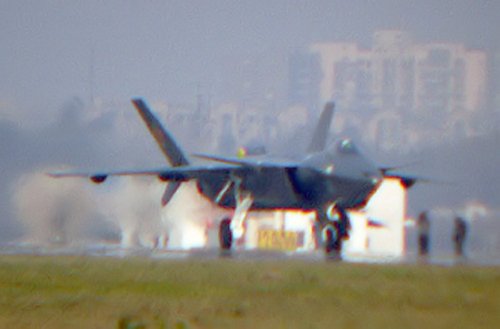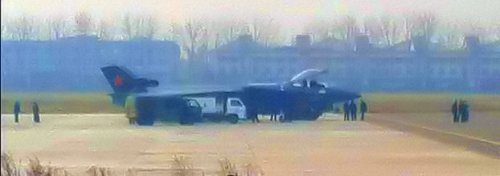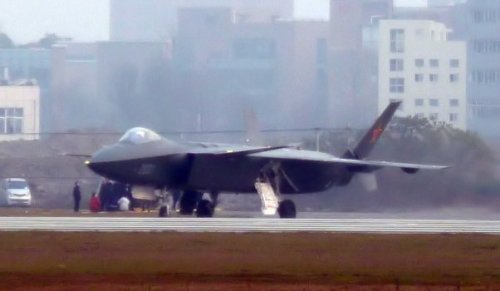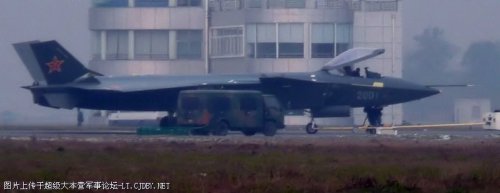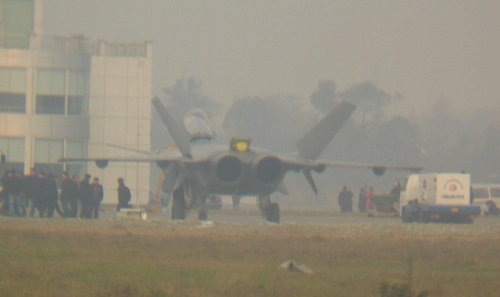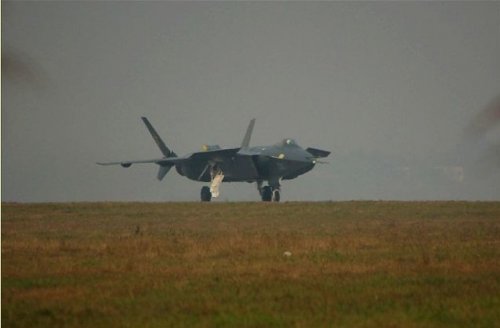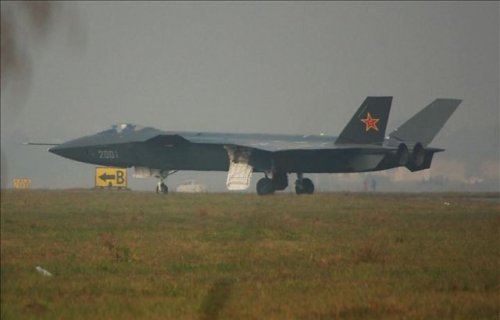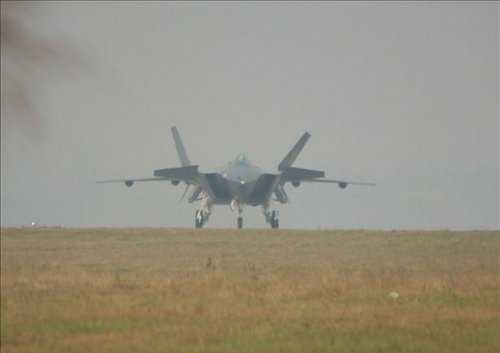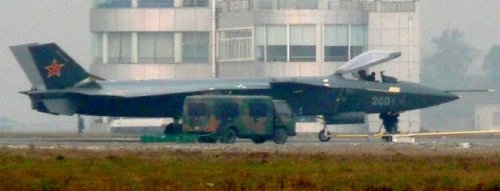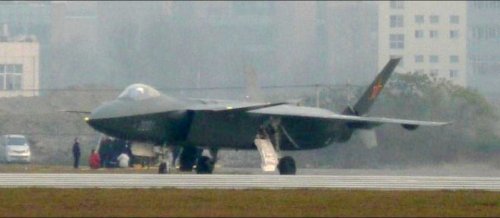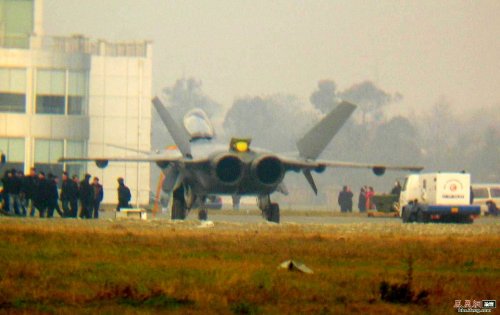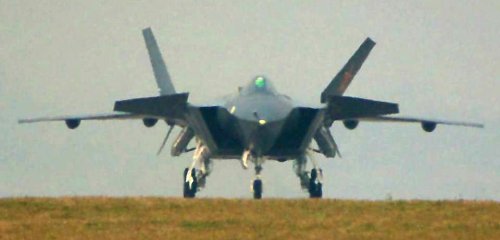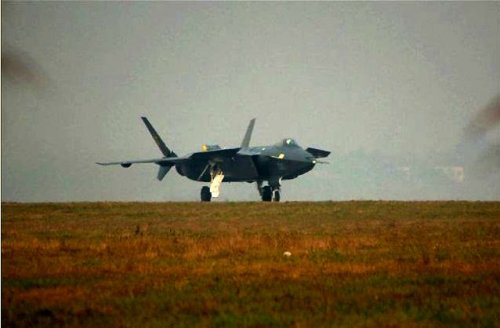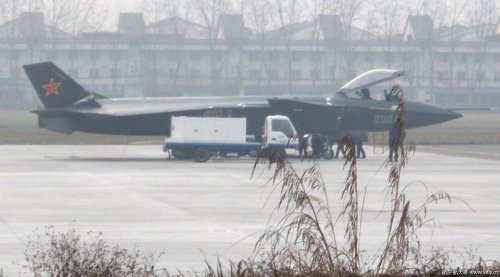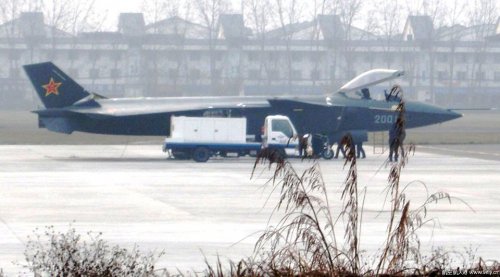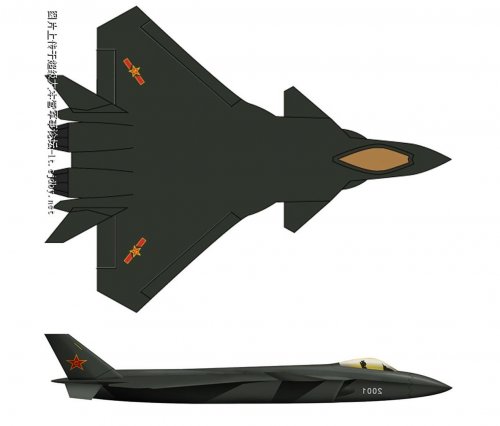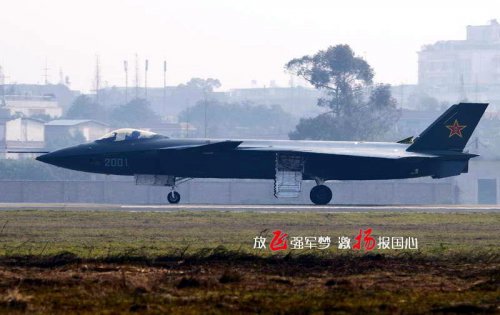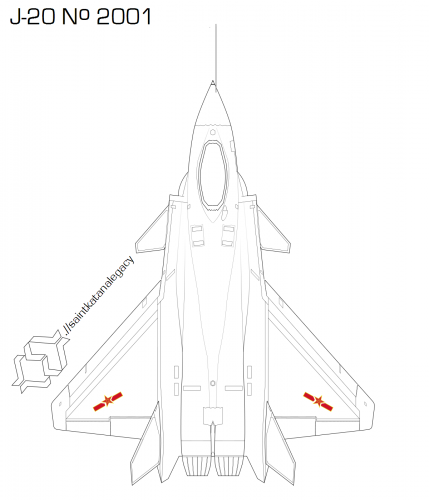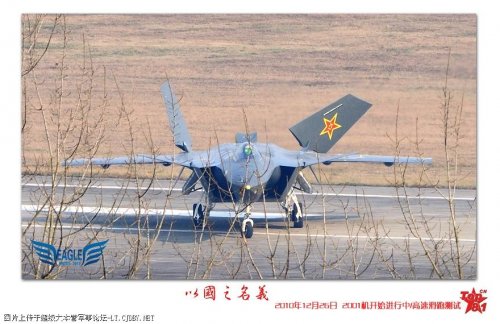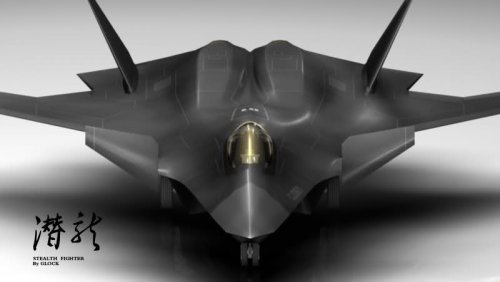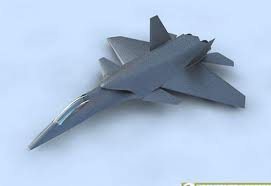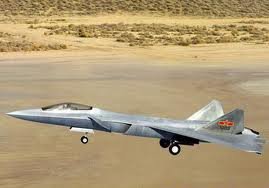You are using an out of date browser. It may not display this or other websites correctly.
You should upgrade or use an alternative browser.
You should upgrade or use an alternative browser.
Photos and analysis of China's J-20 fighter as it nears first flight
- Thread starter Foxglove
- Start date
- Status
- Not open for further replies.
S
sublight
Guest
Since everybody thought "raptorsky" was so hilarious, is this thing going to be "General Tso's Raptor"? 
Dreamfighter
'Senior Something'
- Joined
- 13 July 2008
- Messages
- 483
- Reaction score
- 646
It still hurts my eyes, seeing a Flatpack with a Raptor's nose.
"Flatnose"?
"Flatnose"?
- Joined
- 18 March 2008
- Messages
- 3,529
- Reaction score
- 983
LowObservable said:As it relates to issues on this thread: doubleplusunsmart to project JSF timelines on to J-20.
Of course because the J-20 is likely NOT a 5th generation aircraft. But if it will have the -30 dbsm level low observability and fused, networked sensors and weapons then it will need the kind of workload seen in the F-35 and F-22 to be developed. If its going to be in service with off the shelf mission systems and only offer frontal arc -10 dbms then it can be in service much sooner. But then it won't be much of a threat to the state of the art.
- Joined
- 18 March 2008
- Messages
- 3,529
- Reaction score
- 983
Orionblamblam said:I cleaned up some of the images a bit.
Where's Michael Dornheim and his Cessna when you need him...
- Joined
- 27 December 2005
- Messages
- 17,748
- Reaction score
- 26,421
Improved contrast.. I've pushed it high to accentuate details rather than be accurate colours.
Attachments
- Joined
- 27 December 2005
- Messages
- 17,748
- Reaction score
- 26,421
Another length estimate: 20.6m.
- Joined
- 27 December 2005
- Messages
- 17,748
- Reaction score
- 26,421
- Joined
- 27 December 2005
- Messages
- 17,748
- Reaction score
- 26,421
I think the wing planform is closer to J-10 than that. Also the canard/intake part looks wrong.
Looking at the design, to me it looks designed for supercruise - front view shows very small cross-sectional area when compared to the length.
Looking at the design, to me it looks designed for supercruise - front view shows very small cross-sectional area when compared to the length.
Abraham Gubler said:If its going to be in service with off the shelf mission systems and only offer frontal arc -10 dbms then it can be in service much sooner. But then it won't be much of a threat to the state of the art.
Even with the WS-10As that are the present state of the art in Chinese engines, it can still supercruise. You only need the kind of excess thrust installed in the F-22A if you're going to do very energy bleeding high alpha manouvers; and need to accelerate rapidly out of a energy sink manouver.
Same thing with the RCS. It just needs to be good enough that combined with it's supercruise that it can score a lopsided enough kill ratio against legacy fighters to make going up against it in anything less than a F-22A a hazardrous proposition. The F-35A might have better sensor fusion and radar than the F-22, but it won't have the supercruise perfromance necessary to challenge a supercruising enemy aircraft.
- Joined
- 18 March 2008
- Messages
- 3,529
- Reaction score
- 983
RyanCrierie said:The F-35A might have better sensor fusion and radar than the F-22, but it won't have the supercruise perfromance necessary to challenge a supercruising enemy aircraft.
Supersonic flight into an air to air engagement against another aircraft that you can’t see but can see you just gets you to your death sooner than a transonic cruise – no matter the positive speed disparity.
http://www.secretprojects.co.uk/forum/index.php?action=dlattach;topic=11656.0;attach=122143;image
Wonder how they are suppressing/lowering the IR signature. Those nozzles look pretty conventional.
On another note, I remember reading that there were two proposals, one canard, and another more conventional tail layout. Could we see another aircraft making an appearance shortly? Or is that too much to ask?? Are they going to have a "flyoff" i.e. yf22 vs yf23...x-32 vs x-35? is this the first competitor being rolled out?
Wonder how they are suppressing/lowering the IR signature. Those nozzles look pretty conventional.
On another note, I remember reading that there were two proposals, one canard, and another more conventional tail layout. Could we see another aircraft making an appearance shortly? Or is that too much to ask?? Are they going to have a "flyoff" i.e. yf22 vs yf23...x-32 vs x-35? is this the first competitor being rolled out?
Tom Thumbz Blues
ACCESS: Restricted
- Joined
- 16 November 2009
- Messages
- 2
- Reaction score
- 0
Two quick points:
Re: “Truckology” - If we know the model of the trucks in question, we know the tire & wheel size allowing for a very accurate yardstick as it were.
Re: Discussion of J-20 capabilities or performance vs. F-22/35 etc. – rather meaningless without a sense of its tactical role and the PLAAF operational level doctrine it supports – i.e we have nothing to measure its presumed performance or capabilities against goals in a real world context.
Back to lurking....
Re: “Truckology” - If we know the model of the trucks in question, we know the tire & wheel size allowing for a very accurate yardstick as it were.
Re: Discussion of J-20 capabilities or performance vs. F-22/35 etc. – rather meaningless without a sense of its tactical role and the PLAAF operational level doctrine it supports – i.e we have nothing to measure its presumed performance or capabilities against goals in a real world context.
Back to lurking....
- Joined
- 1 April 2006
- Messages
- 11,394
- Reaction score
- 10,302
try to start reading say from here http://www.secretprojects.co.uk/forum/index.php/topic,4349.0.htmlkcran567 said:Are they going to have a "flyoff" i.e. yf22 vs yf23...x-32 vs x-35? is this the first competitor being rolled out?
611/CAC won, 611/SAC lost competition. There will not be any 'fly-off'
- Joined
- 21 December 2006
- Messages
- 1,243
- Reaction score
- 1,095
WARNING: I just went for a look at Key Forum's J-20 pages and I got the Google Chrome red screen warning that visiting it may harm my computer. Looks like there may be a virus/trojan on their server.
Matej
Multiuniversal creator
What I didn't get are those weird landing gear doors. Are they expendable and supposed to break during any harder landing or the main landing gear doesn't have any dumping? Its lover edge seems to be lower than the center of the wheel!
Email communication received from APA - Dr Carlo on J-20
Australia Air Power on J-20 , posting in full
Dr Carlo Kopp
Over the last few days imagery of what is claimed to be China's new stealth fighter has appeared on a range of Chinese Internet sites. There have been no official disclosures as yet, so many of the claims appearing in the media may only be speculation presented as fact.
The aircraft may be a technology demonstrator or a prototype for a mass production fighter aircraft. The latter is however much more likely, given that the PLA Chief of Air Staff claimed an IOC later in the decade.
What the imagery shows is a large fighter, approaching the size of an F-111, with a canard delta configuration and pair of outward canted all moving vertical tails. This configuration will provide good sustained supersonic cruise performance with a suitable engine type, and good manoeuvre performance in transonic and supersonic regimes.
Of most interest is the stealth shaping, which is considerably better than that seen in the Russian T-50 PAK-FA prototypes and in the F-35 Joint Strike Fighter. The Chinese design appears to be largely built around the stealth shaping design rules employed in the F-22A Raptor. The chined nose section and canopy are close in appearance to the F-22. The trapezoidal inlets are closest to the F-22, but employ an F-35 style boundary layer control design. The wing fuselage join angle, critical for side aspect stealth, is very similar to the F-22 and superior to the Russian T-50 PAK-FA prototypes and the F-35 Joint Strike Fighter. The flat lower fuselage is optimal for all aspect wideband stealth. Planform alignment is impossible to assess until in flight imagery becomes available.
The aft fuselage, tailboom, strakes and nozzles are not compatible with high stealth performance, but may only be stop gap measures to expedite flight testing of a prototype. The airframe configuration and aft fuselage would be compatible with an F-22 style 2D TVC nozzle design, or a non-TVC rectangular nozzle designed for controlled infrared emission and radio-frequency stealth.
The PLA have not disclosed the engine type. There are claims that the Russians supplied supercruise capable 117S series engines - these would not be sufficient to extract the full performance potential of this advanced airframe.
The airframe configuration is compatible with ventral and side opening internal weapon bays, and large enough to match or exceed the internal weapons payload of the F-22A Raptor. Internal fuel fraction may also be high, given the fuselage configuration and large internal volume of the big delta wing.
Other unknowns are the intended sensor suite. China has yet to demonstrate an AESA radar, or an advanced indigenous emitter locating system. However, these could become available by the time this airframe enters production.
The size of the airframe, and its evident focus on supersonic persistence, suggests at a minimum an intention to provide a long range interceptor for air control in the Second Island Chain geography. This capability by default would provide the ability to penetrate an opposing IADS to destroy assets like AWACS, other ISR systems, and tankers. Suffice to say, with suitable internal weapons, the design could be employed as a penetrating strike aircraft, in the combat radius class of the F-111 or Su-34 Fullback.
The notion that an F-35 Joint Strike Fighter or F/A-18E/F Super Hornet will be capable of competing against this Chengdu design in air combat, let along penetrate airspace defended by this fighter, is simply absurd.
APA will produce a detailed analysis at a future date, once more technical material becomes available.
Some excellent analysis of this system by Bill Sweetman, Editor of DTI, can be located at:
J-20 - Denial Is Not An Option
China's Stealth Striker
- Joined
- 17 October 2006
- Messages
- 2,393
- Reaction score
- 1,197
Abraham Gubler said:Supersonic flight into an air to air engagement against another aircraft that you can’t see but can see you just gets you to your death sooner than a transonic cruise – no matter the positive speed disparity.
That only works if one of you is stealthy and RoEs and weapons allow the LO aircraft to decide the engagement outside detection range. Between two aircraft with equivalent frontal LO, speed + altitude (J-20's wing loading is much lower than F-35A) is an advantage in missile kinematics and engagement control.
- Joined
- 2 January 2006
- Messages
- 659
- Reaction score
- 283
Matej said:What I didn't get are those weird landing gear doors. Are they expendable and supposed to break during any harder landing or the main landing gear doesn't have any dumping? Its lover edge seems to be lower than the center of the wheel!
There's a decent side on view on Key that shows the main gear doors are forward of the legs so these doors may actually close shut once the gear is deployed. It is afterall the prototype and only working up for first flight so possible they have disabled the door close procedure and checks during this testing phase. Its just too early to tell until the aircraft flies and starts to cycle its undercarriage.
Personally i like the look it, and it will be interesting to see how this develops over the coming years. The interesting thing will be if or when the production version enters service how it its equiped and how it will be utilised by the PLAAF ?.
So Trumpeter or Bronco to produce a new model kit of kit before Christmas 2011 ? ;D (probably sooner)
- Joined
- 18 March 2008
- Messages
- 3,529
- Reaction score
- 983
LowObservable said:Abraham Gubler said:Supersonic flight into an air to air engagement against another aircraft that you can’t see but can see you just gets you to your death sooner than a transonic cruise – no matter the positive speed disparity.
That only works if one of you is stealthy and RoEs and weapons allow the LO aircraft to decide the engagement outside detection range. Between two aircraft with equivalent frontal LO, speed + altitude (J-20's wing loading is much lower than F-35A) is an advantage in missile kinematics and engagement control.
Note the bolded sections... :
As to ROE that isn't quite true. The stealthy aircraft can decide the engagement geometry outside the detection zone of the target. So he can turn a head to head vector into a stern conversion without entering the field of regard and detection range of the target's radar against his RCS and come up on the flank or tail of the less stealthy aircraft to get a visual confirmation before doing the deed.
Most fighters unable to cruise supersonically still have a useable supersonic capability to give themselves that extra kinematic advantage. Supercruise is great for spending little time inside a defended area you want to bomb or for going from a CAP station to an intercept point. But its advantage in air to air combat is minimal.
- Joined
- 3 June 2006
- Messages
- 3,094
- Reaction score
- 3,964
Thorvic said:There's a decent side on view on Key that shows the main gear doors are forward of the legs so these doors may actually close shut once the gear is deployed.
Attachments
QuadroFX
Russia, Chelyabinsk
- Joined
- 4 May 2008
- Messages
- 2,439
- Reaction score
- 762
The design of the ventral fins is far from ideal in terms of broadside RCS - better not to have any projecting vertical surface below the plane of the wing waterline. Maybe it's a concession to supersonic or high alpha directional stability? This to me shows an emphasis on maneuverability over all-aspect LO. Unless TV nozzles will eventually be retrofitted - Then you could possibly get rid of the ventrals.
The CFD pictures posted by Paul on page 13 show roughly the same configuration WITHOUT ventrals. Of course you usually end up adding ventrals AFTER wind tunnel tests showed you you didn't have adequate stability, so that doesn't prove much!
Anyway, just saying that there would be much to gain if they could get rid of them. Seems weird they're there in the first place.
The CFD pictures posted by Paul on page 13 show roughly the same configuration WITHOUT ventrals. Of course you usually end up adding ventrals AFTER wind tunnel tests showed you you didn't have adequate stability, so that doesn't prove much!
Anyway, just saying that there would be much to gain if they could get rid of them. Seems weird they're there in the first place.
saintkatanalegacy
Little Miss Whiffologist
- Joined
- 31 March 2009
- Messages
- 718
- Reaction score
- 17
saintkatanalegacy
Little Miss Whiffologist
- Joined
- 31 March 2009
- Messages
- 718
- Reaction score
- 17
the aerodynamic configuration is highly influenced by the MiG 1.44; the ventral fin are more for stability during maneuvers... which explains why they are fixed at the rear
though you can do away without them with the proper flight control system
the fuselage-cockpit cross sectioning seem to indicate a similar approach to the PAK-FA's drag reduction patent from how the body blends as it progresses towards the engines
from how the rear is shaped, it somehow hints flat nozzle configuration in the future very similar to the F-22...
I reckon they could also go for a less draggy vertical tail by doing a similar approach with the PAK-FA's tail though the front end seems to be a vortex generator. curiously though, the mini strake just above the DSI is aligned with the tail; the aerodynamics involves "experimental" design features coupled with established ones(ventral fin) most probably to have some degree of safety in flight testing...
the intake duct would be a combination of DSI and simple S-duct(half-offset?) with the DSI blocking the compressor face and easing out pressure recovery using the duct's length
given the size of the aircraft, it should be able to carry at least 6-8 missiles...
front hemisphere seems very clean at X and Ku band while rear is nicely spaced for L band(?); canards won't be much of an issue edge-wise... the chines and edges seem to be heavily RAM'd given its lighter color on very high contrast pictures(with edge overlay); the upward dihedral of the canard is also a "blessing" in that it won't be interacting much with the wing assuming the beam is horizontal and the canard isn't moving much
overall, it's a long stable aircraft...
though you can do away without them with the proper flight control system
the fuselage-cockpit cross sectioning seem to indicate a similar approach to the PAK-FA's drag reduction patent from how the body blends as it progresses towards the engines
from how the rear is shaped, it somehow hints flat nozzle configuration in the future very similar to the F-22...
I reckon they could also go for a less draggy vertical tail by doing a similar approach with the PAK-FA's tail though the front end seems to be a vortex generator. curiously though, the mini strake just above the DSI is aligned with the tail; the aerodynamics involves "experimental" design features coupled with established ones(ventral fin) most probably to have some degree of safety in flight testing...
the intake duct would be a combination of DSI and simple S-duct(half-offset?) with the DSI blocking the compressor face and easing out pressure recovery using the duct's length
given the size of the aircraft, it should be able to carry at least 6-8 missiles...
front hemisphere seems very clean at X and Ku band while rear is nicely spaced for L band(?); canards won't be much of an issue edge-wise... the chines and edges seem to be heavily RAM'd given its lighter color on very high contrast pictures(with edge overlay); the upward dihedral of the canard is also a "blessing" in that it won't be interacting much with the wing assuming the beam is horizontal and the canard isn't moving much
overall, it's a long stable aircraft...
- Joined
- 26 October 2010
- Messages
- 152
- Reaction score
- 26
Steve Pace
Aviation History Writer
- Joined
- 6 January 2013
- Messages
- 2,266
- Reaction score
- 225
From what I've seen re J-20 it seems to be the real thing. -SP
donnage99
ACCESS: Top Secret
- Joined
- 16 June 2008
- Messages
- 1,355
- Reaction score
- 870
Typical of Kopp for omitting what doesn't work toward his agenda. He "forgot" to mention how the canards being tilted and positioned in a different angle from the wings might add more than a few additional "spikes" from all angles, not just frontal.Austin said:Email communication received from APA - Dr Carlo on J-20
Australia Air Power on J-20 , posting in full
Dr Carlo Kopp
Of most interest is the stealth shaping, which is considerably better than that seen in the Russian T-50 PAK-FA prototypes and in the F-35 Joint Strike Fighter. The Chinese design appears to be largely built around the stealth shaping design rules employed in the F-22A Raptor. The chined nose section and canopy are close in appearance to the F-22. The trapezoidal inlets are closest to the F-22, but employ an F-35 style boundary layer control design. The wing fuselage join angle, critical for side aspect stealth, is very similar to the F-22 and superior to the Russian T-50 PAK-FA prototypes and the F-35 Joint Strike Fighter. The flat lower fuselage is optimal for all aspect wideband stealth. Planform alignment is impossible to assess until in flight imagery becomes available.
- Joined
- 18 March 2008
- Messages
- 3,529
- Reaction score
- 983
The actual professional LO engineer’s analysis I’m reading is very dismissive of the J-20. In the frontal aspect it has multiple planes (four) and subsequently could never achieve the kind of <-10 dbsm levels of RCS.
- Joined
- 17 October 2006
- Messages
- 2,393
- Reaction score
- 1,197
AG - If he is an actual professional LO engineer and you're reading his report, how come you're discussing it on a public forum? And if he's drawing conclusions without planform imagery, I would pull his LO License then and there.
Donnage - why would the out-of-plane angle of the canards be a problem? That was not the case with the YF-23 tails.
Seems to me that a lot of people are getting caught up in an "it's different so it's bad" attitude. As noted above, we haven't seen the plan view of the jet so it is premature to jump to conclusions about edges and alignments - and after all neither the F-22 nor F-35 has a lot of T/E sweep.
Neither is there anything intrinsically wrong with canards for LO - they were on some of the early CALF designs. The USN distrusted them, which was one reason that they were not used on JSF.
Donnage - why would the out-of-plane angle of the canards be a problem? That was not the case with the YF-23 tails.
Seems to me that a lot of people are getting caught up in an "it's different so it's bad" attitude. As noted above, we haven't seen the plan view of the jet so it is premature to jump to conclusions about edges and alignments - and after all neither the F-22 nor F-35 has a lot of T/E sweep.
Neither is there anything intrinsically wrong with canards for LO - they were on some of the early CALF designs. The USN distrusted them, which was one reason that they were not used on JSF.
- Joined
- 18 March 2008
- Messages
- 3,529
- Reaction score
- 983
LowObservable said:AG - If he is an actual professional LO engineer and you're reading his report, how come you're discussing it on a public forum? And if he's drawing conclusions without planform imagery, I would pull his LO License then and there.
Because he’s just doing the same thing we are doing: shooting the breeze with others of shared interests. This is a long way from talking about issues that are not in the public domain or breeching security clearances. But it does illustrate just how inaccurate the common, public accepted view of what constitutes LO design is.
LowObservable said:As noted above, we haven't seen the plan view of the jet so it is premature to jump to conclusions about edges and alignments - and after all neither the F-22 nor F-35 has a lot of T/E sweep.
Well aircraft are built in three dimensions and radars scan up and down not just side to side… So even if all your horizontal lines are aligned (as a plan view would indicate) all your vertical lines could not be (as a front view would indicate) and you will have a big RCS.
LowObservable said:Seems to me that a lot of people are getting caught up in an "it's different so it's bad" attitude.
LOL!!! So it’s OK to declare this is a 5th generation aircraft and the end of US and ‘friends of US’ airpower dominance based on the appearance of a nose chine and a dark grey paint job but it’s not OK to see things missing and display some logical scepticism. Like the PAK FA this appears to be a very mediocre attempt at a 5th generation aircraft.
donnage99
ACCESS: Top Secret
- Joined
- 16 June 2008
- Messages
- 1,355
- Reaction score
- 870
What does the yf-23's tails have anything to do with this? I already explained my reasoning on page 13 and I don't think I could be any clearer.LowObservable said:Donnage - why would the out-of-plane angle of the canards be a problem? That was not the case with the YF-23 tails.
We haven't even talked about trailing edge alignments yet. And from more recent photo of the unswept trailing edge from rear, its RCS reduction isn't getting any better.Seems to me that a lot of people are getting caught up in an "it's different so it's bad" attitude. As noted above, we haven't seen the plan view of the jet so it is premature to jump to conclusions about edges and alignments - and after all neither the F-22 nor F-35 has a lot of T/E sweep.
Again, I already explained the difference in LO treating between the j-20's canards and those of CALF/JAST concepts on page 13.Neither is there anything intrinsically wrong with canards for LO - they were on some of the early CALF designs.
There might not be any contests, but the Chinese probably still have something up their sleeves. Chinese Military Aviation reports rumours of a 3.5(4th?) generation conventional configuration aircraft being developed by Shenyang.flateric said:try to start reading say from here http://www.secretprojects.co.uk/forum/index.php/topic,4349.0.htmlkcran567 said:Are they going to have a "flyoff" i.e. yf22 vs yf23...x-32 vs x-35? is this the first competitor being rolled out?
611/CAC won, 611/SAC lost competition. There will not be any 'fly-off'
In the pic showing the rear of the J-20 there's a raised structure between the fins which reminds me strongly of the Sukhoi T-50 parachute housing. I wonder, is it the coincidental effect of natural logic, leading to similar solutions in similar circumstances, or perhaps some Sukhoi engineers were involved?
Rousseau, I fully agree with you, the aircraft is butt-ugly, even the J-10 looks more graceful. I had hoped to
see something like this:
Attachments
- Joined
- 6 August 2007
- Messages
- 3,894
- Reaction score
- 5,978
PLA doctrine, to the best of my knowledge, does not really have a place for VLO as we know it. This does not yet appear to be a VLO aircraft in the traditional sense as well, which makes sense. It is no B-2, F-117, or F-22. However, it could easily be LO in the same way that the Super Hornet has significant LO treatments, but it does not have the multi aspect multi band VLO of something like an F-22.
The visible apertures on the aircraft may be far more interesting than the canard.
I was not aware that supercruise has been used in combat. Has the above been demonstrated? I know that for intercepts the AK F-22s carry external tanks, with which they can't supercruise to intercept.
The visible apertures on the aircraft may be far more interesting than the canard.
Abraham Gubler said:Most fighters unable to cruise supersonically still have a useable supersonic capability to give themselves that extra kinematic advantage. Supercruise is great for spending little time inside a defended area you want to bomb or for going from a CAP station to an intercept point. But its advantage in air to air combat is minimal.
I was not aware that supercruise has been used in combat. Has the above been demonstrated? I know that for intercepts the AK F-22s carry external tanks, with which they can't supercruise to intercept.
Pyrrhic victory
This is going to hurt
- Joined
- 31 January 2008
- Messages
- 75
- Reaction score
- 83
The pace of aerospace industry seems to be increasing from the Peace Dividend lows. The last couple years have had some major reveals: PAK-FA, J-20, RQ-170, GA Avenger, Phantom Ray, Taranis, nEUROn and X-47B. Way better than the Warmed over Cold War stuff from the 1990s and early aughts.
- Joined
- 18 March 2008
- Messages
- 3,529
- Reaction score
- 983
quellish said:I was not aware that supercruise has been used in combat. Has the above been demonstrated? I know that for intercepts the AK F-22s carry external tanks, with which they can't supercruise to intercept.
The ATF specification design mission was for a 100 NM Mach 1.5 dash at 40,000 feet without reheat after loiter. In the case of the mission with tanks this could be to increase loiter time and/or loiter distance from base with a supersonic dash (tanks dropped) or without a dash (point defence). The advantage of the long supersonic dash is it allows you to cover more airspace with less aircraft. Compared to a transonic dash (Mach 0.95) fighter your CAP points can be 50% further apart (in a barrier CAP) and still ensure interception at distance within the required time. When the aircraft are close enough for combat the transonic dash fighter can accelerate to equivalent Mach 1.5 using reheat to enter the engagement with high energy.
Long supersonic dashes have been used plenty of times in air combat to achieve an interception. Of course most of these have relied upon reheat to achieve the speed and obviously have not had the fuel to hang around before hand on a CAP loiter and/or dash as long compared to the supercruiser. But end result is basically the same. This idea that supercruising adds some kind of super capability against non supercruisers when engaged in combat is ridiculous. Its advantage is all about pre combat manoeuvre by providing speed endurance.
- Status
- Not open for further replies.
Similar threads
-
-
American fighters in the defense of China (January 28, 1932 to August 15, 1945)
- Started by Justo Miranda
- Replies: 1
-
Shenyang Jianjiji-11 / J-11 Lightweight Fighter
- Started by Deino
- Replies: 11
-
-
SAAB, Svenska Aeroplanaktiebolaget, Svenska Aeroplan AB, Saab AB aircraft list.
- Started by blockhaj
- Replies: 39

